Elemental
Haines Gallery proudly presents Elemental, a group exhibition featuring new and recent works by John Chiara, Binh Danh, Chris McCaw and Meghann Riepenhoff, four West Coast photographers who create handcrafted prints that celebrate and collaborate with the natural world.
The works in Elemental are singular and unique photographic objects, defined as much by how they are made as by what they depict. The artists on view are known for their analog processes that explore the medium’s fundamental materials of chemistry and light. In their use of both newly invented and antiquated processes, each embraces the forces of nature to create their work: sun and light, as all photography does, but also water, weather, temperature, and the spin of the earth. Some works are abstract and painterly impressions of the landscape; others ask us to reconsider our relationship to and memory of well-known sites and monuments. Throughout, their innovative approaches to landscape and photography invite us to experience the world anew.
Elemental coincides with the traveling exhibition Ansel Adams in Our Time, on view at the de Young Museum from April 8 to July 23. Initiated by the Museum of Fine Arts, Boston, Ansel Adams in Our Time was presented at Crystal Bridges Museum of American Art and Portland Art Museum before coming to San Francisco, and includes work by Danh, McCaw, and Riepenhoff.
John Chiara (b. 1971, lives and works in San Francisco, CA) describes his process as “part photography, part sculpture, and part event.” Printing directly onto photographic paper with his hand-built, large-format cameras, Chiara’s landscapes retain the visible vestiges of their creation: uneven hand-cut edges, tape marks, light leaks, subtle chemical streaking. Elemental includes images of San Francisco and evocative, black-and-white scenes of the Swiss Alps, the latter created during an extended artist residency in 2020. At once dream-like and lucid, with natural and man-made features emerging in razorsharp focus, the work speaks to the elusive contours of memory as they relate to a specific moment or place.
Binh Danh’s (b. 1977, lives and works in the San Francisco Bay Area, CA) daguerreotypes of Yosemite, Grand Canyon, and other US National Parks demonstrate his command of an exacting nineteenth-century process, inviting us to see ourselves (literally) reflected in his plates. Extending the pursuit of pioneering photographers such as Ansel Adams and Carleton Watkins — whose iconic images the artist had seen long before stepping foot in these parks — Danh’s contemporary daguerreotypes expand our experience of these sites through his distinct perspective as a Vietnamese American. Idyllic landscapes are layered with timely questions of access and belonging, exclusion and displacement, and who is allowed to be behind the camera.
Chris McCaw (b. 1971, lives and works in Pacifica, CA) chases the sun to create his elegantly composed landscapes, capturing its presence as circular burns or searing arcs over the horizon. The powerful lenses within his hand-built cameras act as magnifying glasses, burning the sun’s path across light-sensitive paper over long exposures in locations ranging from the Mojave Desert to the Arctic Circle. The works result from a careful choreography between artist and nature, dependent as much on the elements as on McCaw’s understanding of his tools. The work disrupts the idea that a photograph is simply a representation of reality, instead becoming a physical record of planetary movement and the passage of time.
Nature is likewise both subject and collaborator in a selection of new cyanotypes by Meghann Riepenhoff (b. 1979, lives and works in Bainbridge Island, WA). Placing paper coated in homemade emulsion directly within the landscape, she invites the elements to physically inscribe themselves onto her materials. Elemental includes examples from her Ice series, created in freezing bodies of water. Riepenhoff’s prints are full of subtle and strikingly diverse details: colors ranging from deep, inky blues to surprising streaks of magenta and green, and ice formations that can appear as crystalline shards or feathery blooms. Informed by temperature and chemical make-up of water, each piece is a wholly unique record of time and place.
-

-

-
 Chris McCawSunburned GSP #909 (Mojave), 2016Unique gelatin silver paper negative29 x 25 inches, framed
Chris McCawSunburned GSP #909 (Mojave), 2016Unique gelatin silver paper negative29 x 25 inches, framed -
 Meghann RiepenhoffIce #168 (28-35°F, Fletcher Bay Road End, WA 01.13.20), 2020Unique Dynamic Cyanotype46 x 56.5 inches, framed
Meghann RiepenhoffIce #168 (28-35°F, Fletcher Bay Road End, WA 01.13.20), 2020Unique Dynamic Cyanotype46 x 56.5 inches, framed -
 Meghann RiepenhoffIce #326 (27-47°F, Confluence of Schel Chelb Ephemeral Stream and Puget Sound, WA 02.25.22), 2022Unique Dynamic Cyanotype47 x 75 inches, framed
Meghann RiepenhoffIce #326 (27-47°F, Confluence of Schel Chelb Ephemeral Stream and Puget Sound, WA 02.25.22), 2022Unique Dynamic Cyanotype47 x 75 inches, framed




















